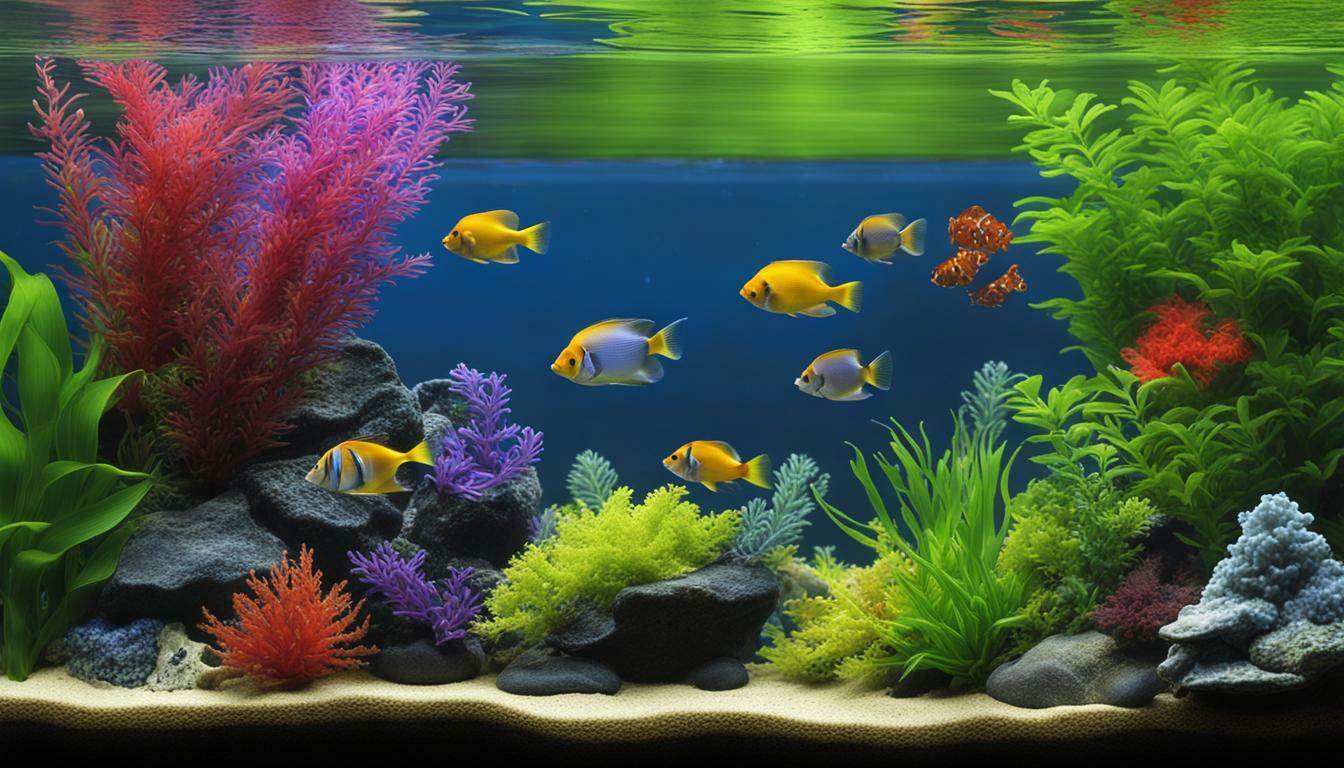Welcome to our comprehensive guide on freshwater and saltwater aquarium fish! Aquariums are a wonderful way to bring aquatic life into your home and create a beautiful and relaxing atmosphere. However, before diving into the world of aquariums, it’s important to understand the key differences between freshwater and saltwater fish, as caring for each type requires a unique approach.
Both freshwater and saltwater aquariums have their benefits and challenges, and it’s essential to choose the type that fits your lifestyle and experience level. In this section, we will provide a brief overview of the main differences between freshwater and saltwater aquarium fish and what you should keep in mind when setting up an aquarium for each type.
Key Takeaways:
- Freshwater and saltwater aquarium fish require different care techniques
- Each type of fish has unique needs based on water chemistry, temperature, and filtration systems
- Choose the type of aquarium setup that aligns with your interests, experience, and dedication to proper care
Setting Up a Freshwater Aquarium
Starting a freshwater aquarium can be a rewarding and exciting hobby that allows you to bring a little piece of nature into your home. However, it’s important to plan and prepare properly to ensure the health and well-being of your fish. Here’s a guide to help you set up a freshwater aquarium:
1. Aquarium Setup
The first step in setting up a freshwater aquarium is selecting the appropriate equipment. You will need a tank, a filter, a heater, lighting, substrate, and decorations. Tanks can be made of glass or acrylic and come in various sizes to fit your space and needs. The filter is essential for keeping the water clean and removing waste. Make sure to choose a filter that suits the size of your tank and the type of fish you will be keeping. The heater is necessary for maintaining a stable water temperature, which is crucial for the health of your fish. Lighting not only illuminates the tank but also supports plant growth and enhances the colors of your fish. Substrate, such as gravel or sand, is used to create a natural environment for your fish and allows beneficial bacteria to grow. Lastly, decorations, such as rocks and plants, provide hiding places and mimic the fish’s natural habitat.
2. Choosing Fish Species
When selecting fish for your freshwater aquarium, it’s essential to choose species that are compatible with each other in terms of size, temperament, and water conditions. Some popular freshwater fish species include tetras, guppies, cichlids, and bettas. Before buying, research the specific needs and care requirements for each species to ensure they will thrive in your aquarium.
3. Aquarium Care
Proper aquarium care is key to maintaining a healthy environment for your fish. It’s necessary to test the water regularly for pH, ammonia, nitrite, and nitrate levels and perform partial water changes every week. Feed your fish a balanced and varied diet and avoid overfeeding, which can lead to poor water quality and health issues. Also, keep an eye out for any signs of disease or stress in your fish, such as unusual behavior or discoloration, and take appropriate action immediately.
By following these steps and providing proper care, you can create a thriving freshwater aquarium that will bring joy and relaxation to your daily life.
The Appeal of Saltwater Aquariums
Saltwater aquariums have gained popularity among fish enthusiasts in recent years, and for good reason. These aquariums offer a unique and fascinating underwater world that cannot be replicated in freshwater setups. The vibrant colors and diverse range of species create a visually stunning display that is hard to resist.
However, setting up and maintaining a saltwater aquarium requires more time, effort, and money than a freshwater one. The water chemistry and filtration systems are more complex, and it can take longer to establish a stable environment for your fish. Additionally, saltwater fish can often be more expensive and challenging to care for than freshwater varieties, but many find the extra effort and investment worth it for the captivating beauty and intrigue of a saltwater aquarium.
Saltwater Aquarium Setup
The first step in setting up a saltwater aquarium is choosing the right equipment, such as a protein skimmer, heater, and high-quality filtration system. It is also essential to select the correct substrate, lighting, and decorations, as these can impact the water chemistry and the health of your fish.
In addition to the physical setup, it is crucial to establish the proper water chemistry for a saltwater aquarium. This includes maintaining the appropriate salinity levels and regularly testing and adjusting the pH, alkalinity, and other chemical parameters to ensure a stable environment for your fish.
Saltwater Fish Species
There is a vast array of saltwater fish species available for aquariums, ranging from small and colorful species like clownfish and gobies to larger and more intricate species like angelfish and butterflyfish. It is crucial to research the specific requirements and compatibility of each species before adding them to your tank, as some can be aggressive or have specific dietary needs.
Additionally, many saltwater aquarium enthusiasts enjoy adding live coral to their tanks for even more visual appeal. However, caring for coral requires specific lighting, water flow, and nutrient levels, making it an additional challenge for those new to saltwater aquariums.
Saltwater Aquarium Care
The maintenance and care of a saltwater aquarium must be consistent and precise to ensure the health and well-being of the fish. Regular water changes and checking water parameters are essential, as saltwater aquariums are more sensitive to changes in water quality than freshwater setups.
Additionally, it is crucial to monitor the behavior and health of your fish and address any issues promptly. Common problems in saltwater aquariums include parasites, infections, and stress-related illnesses, which can be treated with appropriate medication and changes in the environment.
While saltwater aquariums can be more challenging to care for than freshwater setups, the rewards can be significant for those willing to put in the effort. With the right equipment, setup, and care, a saltwater aquarium can provide a fascinating and captivating display of marine life.
Water Parameters and Maintenance
Creating and maintaining the ideal water conditions for your aquarium is crucial for the health and well-being of your fish. However, the water parameters and maintenance requirements differ between freshwater and saltwater aquariums.
Water Parameters for Freshwater Aquarium
For a freshwater aquarium, the pH levels typically range from 6.5 to 7.5, while the temperature can be between 75°F and 80°F. It’s essential to monitor the ammonia, nitrite, and nitrate levels frequently, as well as water hardness. A proper filtration system is necessary to remove excess waste and debris from the water, promoting clean and healthy water for your fish.
Water Parameters for Saltwater Aquarium
In contrast, a saltwater aquarium requires a higher pH level of 8.2 to 8.4 and a warmer temperature of 77°F to 82°F. Additionally, salinity levels must be kept between 1.023 to 1.025. Nitrate and phosphate levels should be kept low through frequent water changes and the use of protein skimmers. The water chemistry must be monitored and balanced carefully to create a suitable environment for the delicate marine life that inhabits it.
Aquarium Maintenance
Regardless of the type of aquarium, regular maintenance is essential to keep your fish healthy. This includes water changes, filter cleaning, and removal of excess waste and debris from the tank. Water changes should be performed weekly for freshwater aquariums and every other week for saltwater aquariums. Filters should be cleaned monthly in freshwater aquariums and biweekly in saltwater aquariums. The aquarium should also be cleaned thoroughly at least once a month to prevent the buildup of harmful bacteria and algae.
By maintaining optimal water conditions and performing regular maintenance, you can ensure a thriving and healthy fish community in your aquarium.
Feeding and Nutrition
Proper nutrition is essential for the health and well-being of your aquarium fish. Different species have different feeding habits and dietary requirements, so it’s important to choose the right type of food for your freshwater or saltwater aquarium fish.
Freshwater Fish Diet: Most freshwater fish are omnivores, meaning they eat both plant and animal-based foods. Commercially available fish food pellets are a convenient and balanced option for many species, but it’s also important to include fresh or frozen foods such as bloodworms, brine shrimp, and vegetables like peas or spinach.
Saltwater Fish Diet: Saltwater fish have more varied dietary requirements. Some are herbivores and require a diet rich in algae and other plant materials, while others are carnivores and need a diet of meaty foods like krill or shrimp. It’s important to research the specific dietary needs of your saltwater fish and offer a balanced diet that meets their needs.
Overfeeding can lead to poor water quality and health issues, so it’s important to feed your fish the appropriate amount and remove any uneaten food from the tank. Additionally, a varied diet can help prevent nutritional deficiencies and keep your fish healthy.
Disease Prevention and Treatment
Fish diseases can be common in both freshwater and saltwater aquariums. It is important to understand the signs of illness, how to prevent outbreaks, and how to properly treat diseases when necessary.
Freshwater Fish Diseases
Common freshwater fish diseases include fin rot, ich, and dropsy. Fin rot is characterized by the gradual deterioration of the fins, and ich manifests as small white spots on the fish’s body. Dropsy is a bacterial infection that causes swelling and fluid retention in the fish’s body.
To prevent disease outbreaks in freshwater aquariums, it is important to maintain good water quality, avoid overfeeding, and quarantine new fish before introducing them to the main tank. When treating diseases, it is essential to identify the specific illness and select an appropriate medication. It is also important to follow dosing instructions carefully and remove activated carbon from the filtration system during treatment.
Saltwater Fish Diseases
Common saltwater fish diseases include marine velvet, white spot disease, and vibriosis. Marine velvet is a parasitic infection that causes a yellowish film to appear on the fish’s body. White spot disease is characterized by the presence of small white dots on the fish’s skin. Vibriosis is a bacterial infection that can cause a range of symptoms, including lethargy and mouth rot.
To prevent disease outbreaks in saltwater aquariums, it is important to maintain stable water parameters, minimize stress for the fish, and avoid overcrowding. When treating diseases, it is essential to identify the specific illness and select an appropriate medication. It is also important to follow dosing instructions carefully and remove any carbon or protein skimming during treatment.
Compatibility and Species Variety
When it comes to creating a community tank, one of the key factors to consider is species compatibility. In both freshwater and saltwater setups, it’s important to choose fish that have similar temperaments, water parameter requirements, and feeding habits.
For freshwater aquariums, some popular community fish include tetras, guppies, and angelfish. It’s important to avoid aggressive species like cichlids, which can disrupt the harmony of the tank. Additionally, make sure to research the specific water parameters and dietary needs of each species to ensure they can coexist peacefully.
When it comes to saltwater aquariums, the task of choosing compatible fish becomes even more challenging. In addition to temperament and dietary requirements, saltwater fish also have specific preferences for tank mates based on their native habitat. For example, fish that live in the reef environment may not get along with fish that live in open water. Researching the natural behaviors and habitats of different species is crucial for creating a successful community tank.
Regardless of whether you choose a freshwater or saltwater setup, one of the most exciting aspects of aquarium keeping is the variety of fish species available. From bright and colorful tropical fish to sleek and elegant marine fish, there’s a species to suit every preference and skill level.
Conclusion
Choosing between a freshwater or saltwater aquarium setup ultimately depends on your personal preferences and level of experience as a fish keeper. While freshwater aquariums may be easier to maintain and less expensive, saltwater aquariums offer a wider range of colorful and unique fish species that require specialized care.
Regardless of which type of aquarium setup you choose, it is important to understand the differences between freshwater and saltwater fish to provide optimal care for your aquatic pets. Water parameters, feeding and nutrition, disease prevention and treatment, and species compatibility are all crucial factors to consider when creating a thriving and healthy aquarium community.
In summary, both freshwater and saltwater aquariums can offer a rewarding and enjoyable hobby for fish enthusiasts. By taking the time to learn about the differences between these two types of aquariums and providing proper care for your fish, you can create a beautiful and vibrant underwater world in your own home.
FAQ
Q: What are the main differences between freshwater and saltwater aquarium fish?
A: Freshwater aquarium fish live in freshwater environments, while saltwater aquarium fish live in saltwater environments. The main differences lie in their habitat requirements, water chemistry, and the types of fish species that can thrive in each type of aquarium.
Q: What equipment do I need to set up a freshwater aquarium?
A: To set up a freshwater aquarium, you will need a tank, a filter, a heater, a light source, substrate, decorations, and water. Additionally, you will need to choose the appropriate fish species, provide them with food, and regularly maintain the water quality.
Q: What are some popular saltwater fish species for aquariums?
A: Some popular saltwater fish species for aquariums include clownfish, tangs, gobies, and wrasses. These fish are known for their vibrant colors and interesting behavior, making them appealing additions to any saltwater aquarium.
Q: What are the key water parameters to monitor in both freshwater and saltwater aquariums?
A: In freshwater aquariums, it is important to monitor parameters such as pH, ammonia, nitrite, and nitrate levels. In saltwater aquariums, additional parameters like salinity and alkalinity need to be monitored. Regular water testing and appropriate maintenance are crucial for the health of the fish.
Q: What should I feed my freshwater and saltwater aquarium fish?
A: Freshwater aquarium fish typically have a varied diet consisting of flakes, pellets, frozen or live foods. Saltwater aquarium fish often require a more specialized diet that includes marine flakes, frozen or live foods, and sometimes even coral or invertebrate supplements. It is important to provide a balanced diet that meets the nutritional needs of the fish.
Q: How can I prevent and treat diseases in my aquarium fish?
A: Disease prevention in both freshwater and saltwater fish involves maintaining optimal water conditions, providing a balanced diet, and avoiding stress. If a disease does occur, appropriate treatment options such as medication or quarantine may be necessary. Regular observation and prompt action are key to minimizing the impact of diseases.
Q: Can I keep different fish species together in the same aquarium?
A: The compatibility of different fish species depends on their behavior, size, and habitat requirements. It’s important to research the specific needs of each species and choose compatible fish that can coexist peacefully in the same tank. Creating a harmonious community tank requires careful consideration and planning.
Q: What are the key differences between freshwater and saltwater aquarium fish?
A: Freshwater and saltwater aquarium fish have different habitat requirements, water chemistry needs, and a diverse range of species available. It’s important to understand these differences when deciding which type of aquarium to set up and care for.
 Skip to main content
Skip to main content


